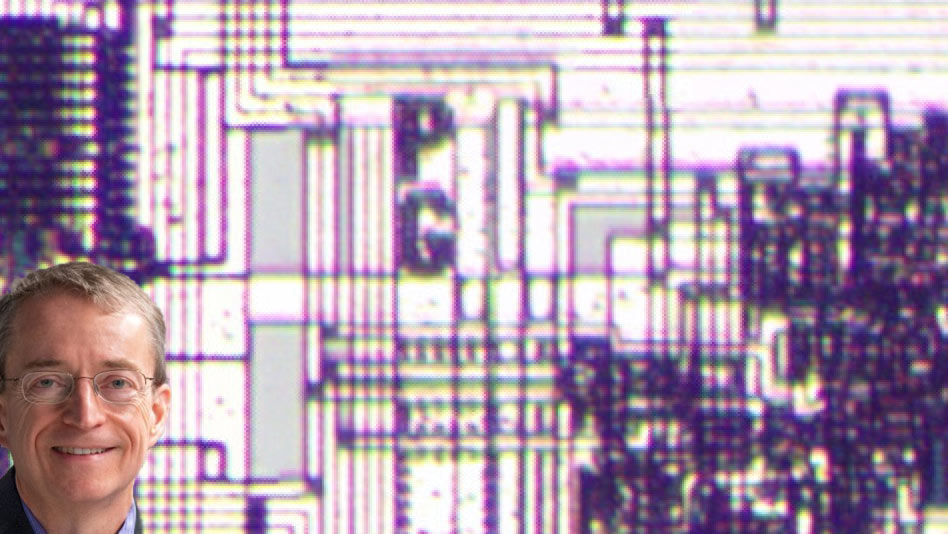Pat Gelsinger's initials are etched into every 386 processor ever made — Intel CEO literally made his mark as a key CPU designer

Current Intel CEO Pat Gelsinger has a long and storied history at the company and was one of the key design engineers behind developing the iconic 386 processor. At the tender age of 24, perhaps Gelsinger thought his work would not be remembered or receive due credit, as it has been revealed the young engineer etched his initials into the very design of the 386 silicon die in two places, indelibly securing his place in history.
Computer History buff Ken Shirriff recently published a retrospective on the Intel 386 processor, and to draw attention to his latest blog about 386 reverse engineering and architectural investigations, he shared a Twitter / X thread. One of his eye-opening observations was that Gelsinger’s initials could be found etched on two areas of the 386 silicon.
Etching initials and/or artwork into silicon dies is a common tactic for chip designers, but this is the first mention of a design, or in this case, initials, being discovered on the iconic 386 processor.
And here are Pat Gelsinger's initials on the 386 die in two places. pic.twitter.com/FBOePqe8gMDecember 16, 2023
Please click 'see more' to expand the Tweet images.
The Intel 386 processor, introduced to the masses in 1986, was a hugely important product for Intel. Originally called the 80386 before being renamed the i386, this processor was the firm’s first 32-bit PC processor. Gelsinger recalls that offering a 32-bit PC processor didn’t lead to immediate accolades, far from it. “They derided us for being extravagant,” he recalled in a Computerworld interview, published in 2008.
The chip had 275,000 transistors, quite the feat for the time, but that's rather paltry compared to today's chips that come with up to 80 billion transistors, or more, per die. The 386 was fabbed on the 1.5 uM node (equivalent to 1500 nanometers), while today's chips have reached 3nm, and future variants will shrink to 1.4nm — and shrink even further as we move into the Angstrom era.
Gelsinger went on to co-author his first book about programming the 386 microprocessor, published in 1987. He was also the lead architect on the 486 processor, which was introduced in 1989. It is claimed that Andy Grove offered Gelsinger the lead architect role on the 486 to keep him from quitting the company. Meanwhile, the 386 had a lengthy run, with production of the processor continuing until September 2007.
Perhaps this longevity is one of the reasons that the Intel 386 CPU has garnered so much attention from Shirriff. The computer history buff reckons that it is “an important milestone,” and highlighted that there are “two interesting and completely different circuits that the 386 uses to implement an XOR gate.” Check out his top-linked blog and social media postings to read more in-depth insights into the 386 processor architecture.
Get Tom's Hardware's best news and in-depth reviews, straight to your inbox.
Bringing you up to date, Mr Gelsinger is steering Intel through a rapidly changing and highly competitive time in the IT industry. The firm recently launched its ground-breaking codename Meteor Lake, or Core Ultra series, processors, heralding the dawn of AI PCs.

Mark Tyson is a news editor at Tom's Hardware. He enjoys covering the full breadth of PC tech; from business and semiconductor design to products approaching the edge of reason.
-
bolweval Reply
That was mine as well, also got the math co-processor too, which was made by Cyrix...Nine Layer Nige said:My first PC had a 386 SX33. The integrated PG definitely made it go faster. -
magbarn I still remember swapping the 40mhz crystal with a 50mhz to overclock my 386 20 to a whopping 25mhz!Reply -
abufrejoval What a shmuck! That explains it!Reply
I never really liked the 80386.
It was too late!
It was too early!
It was incomplete!
And it was boring!
It was too late, because I had just spent all my money on a 80286 and there was just no way I could replace it with the "real thing" a year later. Soon after it came out my local Computer dealer rang the doorbell and wanted to deliver a Compaq 80386, that very first machine that had this CPU. Saying no has never been harder, because as it turned out my dad had ordered that machine for his business and they had mistaken us...
I sooo much wanted to say "yes, leave it here with me"...
It was too early, because I had spent a year on writing a bit of software, which would take my GEM applications written in Turbo Pascal, basically relink and modify them in such a way that they ran in 80286 protected mode, returning to REAL-mode every time a GEM drawing routine or DOS call needed to be made: it allowed "vast" amounts of data to be held in RAM (a whopping 1.5MB via an Intel AboveBoard) for the mapping-visualization software I was writing.
With a true 32-bit machine out, that was obviously no longer going to be attractive, even if it took ages for 32-bit OSs with real graphics to appear. Even Unix was all text back then, I ran Microport System V.2 on my 80286, my dad had gotten a proper 32-bit Unix from UnixWare, that was vastly more stable.
It was incomplete, because it supported virtualization only for 8086 DOS machines! That was just unforgivable, a totally crippling and obviously quite intentional oversight, PG, I am looking at you!
I mean, even then the IBM 360/67 had been twenty years old by then. Everbody knew how little it takes to add virtualization capabilities to a 32-bit CPU. Still Intel only implemented a vitual 8086 mode, that's only ever been useful for a few years and left out the real thing, evidently because they were afraid at how much fewer CPUs they were going to sell.
I rejoiced when Mendel Rosenblum and Diane Greene found out how they could use the 80486SL system management mode (SMM) (and binary translation) to implement a hypervisor anyway and immediately bought the very first VMware software release (which today would be called VMware Workstation 1.0).
And just to show their spite, Intel fired back and invalidated most of VMware's patents rather quickly when they finally implemented hardware virtualization a little later and sponsored the adaption of Xen to make use of it, when Xen had previously only been a software virtualization platform.
It proved beyond doubt, how intentional that feature cut had been before and how mad they were at VMware for getting around their functional fence.
And PG going to VMware and Diane Greene getting fired would close the circle, if there wasn't a 4 year Paul Maritz tenure between that. Still, I could easily see this as late revenge...
And to be honest the 80386 was also already boring, even against Intel's own. The 80432 seemed so much more interesting (ok, it was a dog) but the iAPX850 ("Cray on a chip") was sooo much cooler! People in my SUPRENUM lab at the time were working on a quad-i860 board and teaching GNU-cc how to schedule loop instances first into the SIMD register sets and then across cores for the extra wide HPC workloads.
What I quite liked was when AMD made that boring CPU 64-bit and thus managed to starve the far more interesting Itanium into a niche. And that was mostly, because the Itanium was quite simply Unobtainium for the Personal Computer. The bean counters eventually even managed to put that HPC CPU into (integer only) database servers! I've always felt sorry for the engineers, but Intel got what they deserved.
I've always hated everything that was either closed or too expensive (Apple managed both after the ] -
MobileJAD Reply
My first PC had a 386SX made by AMD, figures, it didn't have the integrated PG, no wonder it sucked.Nine Layer Nige said:My first PC had a 386 SX33. The integrated PG definitely made it go faster. -
Chung Leong Reply
I remember putting a system like that together for my sister. When I turned it on for the first time black smoke started coming out from under the Cyrix coprocessor. No harm done though. Just had to rotate the chip 180 degrees.bolweval said:That was mine as well, also got the math co-processor too, which was made by Cyrix... -
bavalpey *while today's chips have reached 3nm, and future variants will shrink to 1.4nm — and shrink even further as we move into the Angstrom era."Reply
This is very misleading. It's extremely unlikely that we'll get below the 1nm level (when you really start needing angstroms). 14A chips are 7 silicon atoms. 7. The smallest you can possibly get is 2A and have it still even be silicon.
There will be no "Angstrom Era" -
bit_user Reply
No, the Cyrix FastMath was one of the better aftermarket FPUs, but Intel did make their own (i.e. the official 80387 or i387). We also had Cyrix, and I remember seeing it mentioned in the POST boot sequence.bolweval said:That was mine as well, also got the math co-processor too, which was made by Cyrix...
More:
https://www.vogons.org/viewtopic.php?f=46&t=65991 -
bit_user Thanks for the history.Reply
Not exactly.abufrejoval said:Even Unix was all text back then,
https://en.wikipedia.org/wiki/X_Window_System#History
I thought the i860 was pretty cool, too. SGI liked using them as geometry engines.